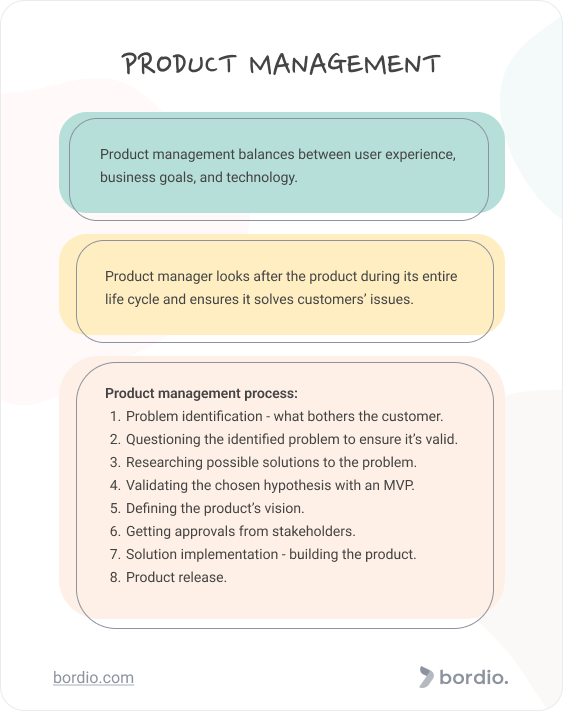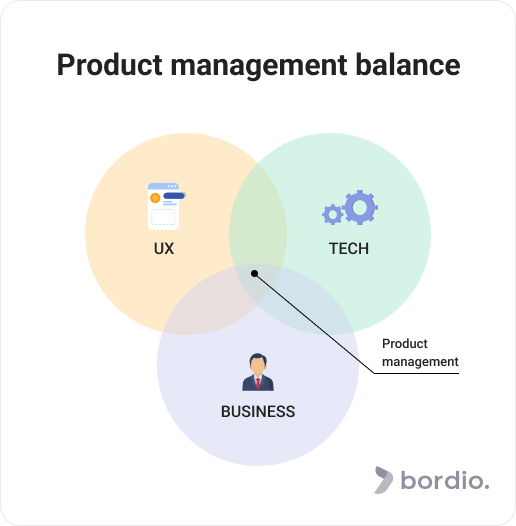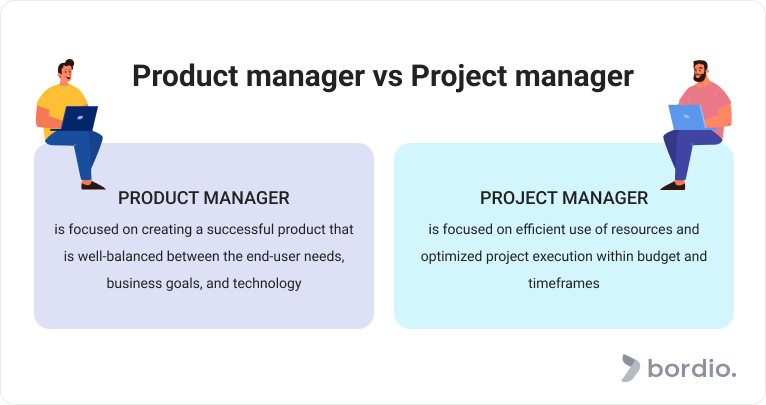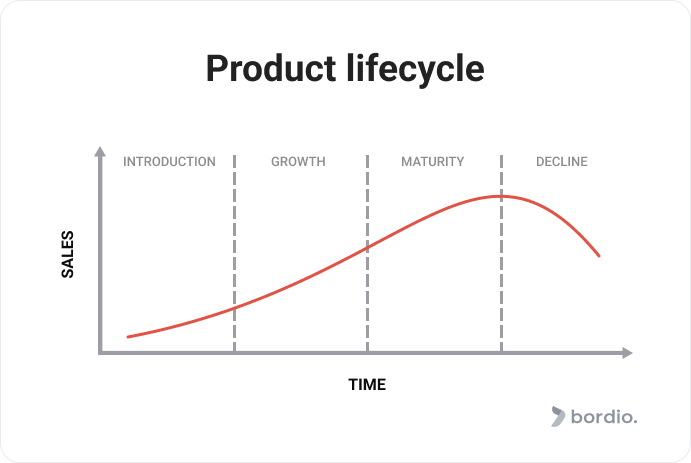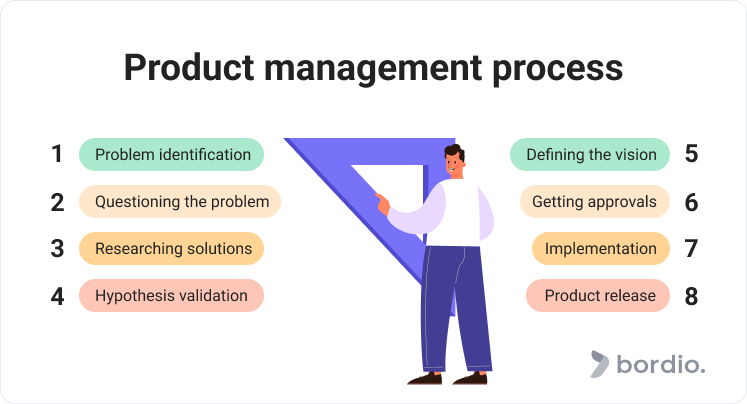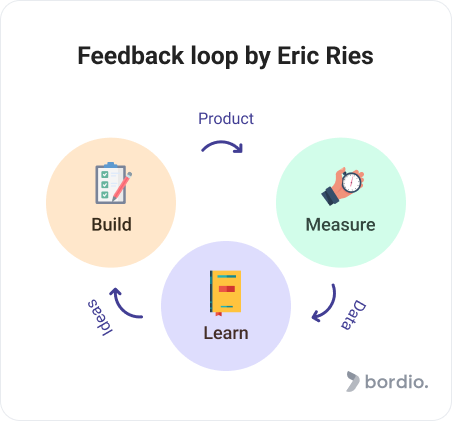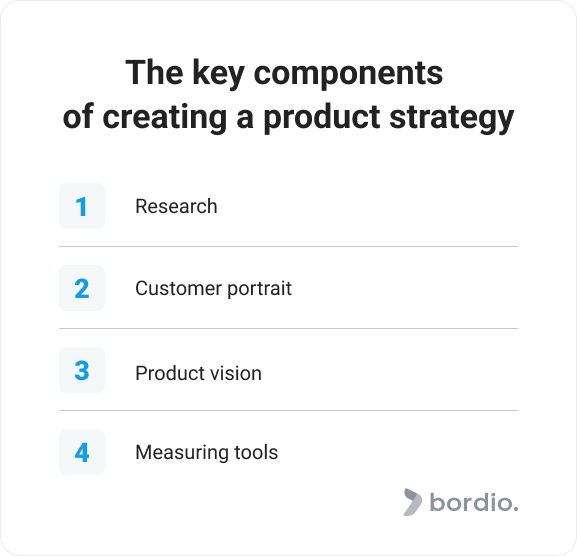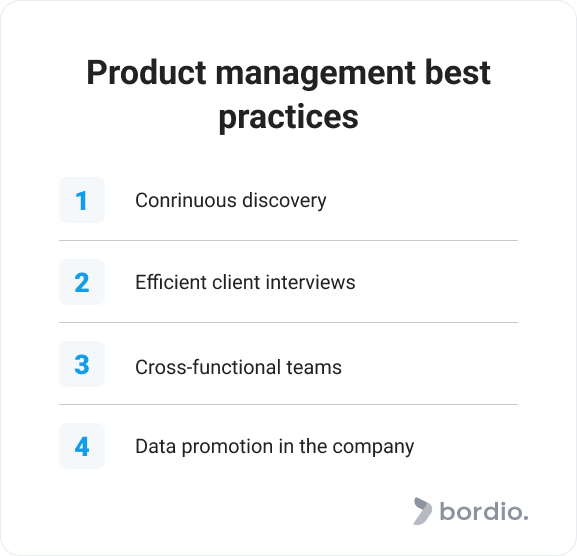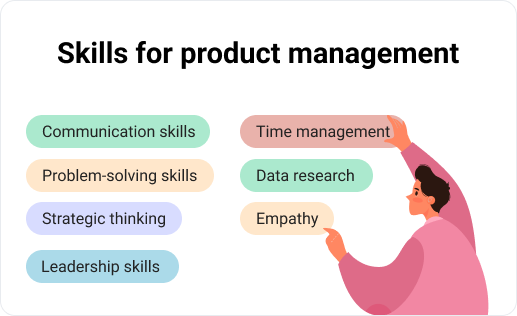Think about a product that you really like. The product that stands out from the competition and makes you instantly fall in love with it. Now think about why you like those products. Is it for their design? Or the intuitive interface? Maybe it ticks all the boxes in terms of functionality?
Whatever it is that made you prefer this product over everyone else, it was created and pushed through as a part of the product management process within the company.
In today’s guide to product management, we will look into the product management process, find out why it matters and how to master it.
What is product management?
Product management is a business function that oversees the product’s entire lifecycle while putting customers’ priorities and preferences first.
Simply put, product management looks after the product and makes sure it’s exactly what the client wants while keeping the business sustainable.
As famously said by Martin Eriksson, product management balances between and unites the three critical points:
- User experience
- Business goals
- Technology
Product management keeps user experience on a high level by carefully listening to customers’ feedback and implementing their wants and wishes into the solution.
The product manager helps achieve the business goals by becoming a middleman between the customer and the company, allowing to build solutions that have value to the end-users and that they are willing to pay for.
At the same time, product management involves making sure the technological aspect of the product is under control and the promised functionality is actually delivered to the end-user with robust and most powerful technology.
Who is the product manager?
The product manager is a specialist that looks after the entire product management process, coordinating the team and making sure the product stays true to its vision. If the product is only in the process of making, then the product manager also oversees the development stages of the process.
Product managers have a long list of responsibilities and they wear many hats on a daily basis. However, if you asked us about their key job, we would likely say – balance. The balance between the end-user and the business. The balance between customer expectations and realistic solutions that can be delivered within the budget and timeframes.
A product manager is NOT a project manager
It is important to note that a project manager and a product manager are two completely different roles. The project manager is focused on efficient use of resources and optimized project execution, meaning staying within the budget and minimizing the time the project takes.
The product manager, in turn, has the ultimate goal of creating a successful product that is well-balanced between the end-user needs, business goals, and technology. For the product manager, the top goal is a fully-functioning product that clients rave about, and they wouldn’t worry too much if creating this masterpiece takes a bit more resources and requires more time than initially anticipated.
There are similarities between project management and product management. They do cross over in some aspects, but it is wrong to consider them the same thing.
Tip: if you’d like to learn more about project managers, go ahead and read our article about their roles and responsibilities and the guide about becoming a project manager.
The product life cycle
The product manager is responsible for the product across all life cycle stages. Let’s cover them briefly before we move on to talking about the product management process.
- Introduction stage: the product is designed, developed, and launched.
- Growth stage: periodic iterations are released to boost sales and growth in the number of new clients.
- Maturity: the focus shifts from acquiring new clients to retaining the existing ones, as well as maintaining and supporting the product’s functionality.
- Decline: that’s when the tough decisions are made whether to remove the product from the market, re-think it completely and release a new version or keep it as is.
The product management process
Before we start talking about the product management process, it is important that we put a disclaimer that there is no single right way of managing a product.
There are best practices and industry standards that a lot of companies follow but ultimately each product manager makes a decision to adapt and adjust their internal process to make it work for the specific company and situation.
In this article, we are sharing the product management process for creating a new product.
Step 1: Problem identification
Product management starts with identifying the customer problem that will be solved.
Problem identification is done through working with customer feedback, current issues with the solution, big company goals, or finding a gap in the market. You can do this by using an AI form builder to create feedback forms for your customers.
In product management, there is no room for assumptions, and another vital part of the process is direct communication with customers through market research and interviews.
Decisions made at this point will determine the fate of the future product (or update of the product), so it needs to be data-driven and not just a wild guess of a group of people.
And while defining the problem requires an almost scientific approach, it is also a very creative process. More often than not, customers can’t articulate what is it that they are missing exactly. The product management team has to somehow translate all the wishes and pains and form them into a new shape – the product.
Throughout all stages of the product lifecycle, the product manager controls and ensures that the problem remains at the center of every step of the process, and all decisions that are made consider the customers’ pain.
Step 2: Questioning the identified problem
This stage is just as important as the first one.
The last thing the company needs is to work on a solution to a problem that doesn’t really exist or it’s too small to target. Not every problem is worth solving, and sometimes there is a reason why there are no current solutions to the problem that exists for a while – it’s simply not worth it.
That’s why working closely on the selected problem and qualifying it further before proceeding with the development is key.
Here are the fundamental questions product managers define at this point:
- How big is the business potential for this problem?
- Is the problem uncomfortable enough for people to pay for the solution?
- Are there any solutions already and how do they work?
Step two of the product management process is more about business objectives and analytics, so the product manager has to step away from focusing on the clients’ needs and prioritize the company’s goals.
Step3: Researching solutions to the problem
Next on the product manager’s digital to-do list comes the solutions research stage where we research and test proposed solutions for the customer problem. The product manager pairs with their product team to come up with ideas and see if they work. Managing team will be easier if you use team tracker software.
Here, it’s important to come up with several solutions and run them by our potential target audience. If we go with just one idea, we can’t really say how it will turn out in real life until we try.
Sometimes, the solutions that we weren’t so crazy about during discussions end up being absolute hits with customers. Yet at the same time, be careful not to spread yourself too thin and end up wasting time on the ideas that aren’t really great but “let’s try them anyway”.
Tip: As you are running the solutions by potential clients, make sure you check in with the internal product development team. Ideas should be challenging but must remain realistic. Otherwise, you end up overpromising and underdelivering, causing harm that will be very hard to fix.
Step 4: Hypothesis validation
The recommended route for hypothesis validation is to create an MVP and conduct A/B testing with groups of customers to determine if the solution would actually be useful and valuable or not.
Some product teams might skip this step if they are short on time or overly confident in their future solution. We have to warn you against such behavior because no matter how much you think the idea is great unless you’ve gotten some form of confirmation from the customer feedback, you are putting yourself in a highly risky situation.
Building an MVP
An MVP, or a Minimal Viable Product, is the most basic version of the product that only includes the core functionality. The idea of the MVP is that it should take little time to create and be provided to customers so that they can share feedback.
Tip: Work on confirming the core features with the team and stakeholders before you create the MVP but don’t go into the road mapping and detailed functionality outline. It’s best to delay it until the MVP tests are successful. Schedule a couple of team and stakeholder meetings in your online calendar planner for the MVP stage to ensure everyone is on top of the process at all times.
During step 2, we are verbally confirming that solution will work for the clients, but in step 3 we actually give them something real to play with.
At this point, the biggest job of the product manager is to create a customer feedback loop. User feedback is absolutely critical for new (and all) products. Create a loop where the customer receives an MVP to test, then shares their thoughts, and then those thoughts are implemented into the next round of the MVP.
Eric Ries, the author of “Lean Startup” emphasizes the importance of feedback loops. In his book, Ries writes that feedback should be the driving force of all MVP iterations and a key deciding factor for product-related decisions.
Another thing that Ries promotes is pivoting. To pivot means to divert from the original plan, and that’s exactly what companies should be doing if they find out that something about the MVP is off. Pivoting can be hard if the team grew attached to their idea but it has to be done to minimize risks and, ultimately, give clients what they want, and not what we think they want.
Partially because there might be a need to pivot at some point, it is important that the MVP is not worked on for too much to the point where it’s almost a finished product.
Tip: Read more about Lean Startup, pivoting, and feedback loops in our detailed article about Lean Startup methodology.
Step 5: Defining the vision
The next step is defining a clear vision for the solution we picked.
Once we’re done with MVPs, it is time to plan the future product thoroughly. Here the product manager curates the roadmap planning process, works on the product strategy, discusses and confirms key milestones, and thinks about the metrics to measure progress and success.
This step can be performed in partnership with a project manager or just by the product manager and the development team alone, depending on the company’s structure.
Tip: Creating a future product vision and outlining the roadmap are classical steps in project management. We’ve prepared two guides that can help you navigate this process: implementation plan in and milestones in project management. Use time schedule maker and make sure you check them out for valuable advice and tips.
The product roadmap best practices
The product roadmap is an action plan on paper. It is used as a reference point that keeps product team members and everyone else on the same page and helps stay true to the long-term goals while working on short-term tasks. Now people more often use alternative online schedule builders.
- The roadmap should be regularly reviewed and updated whenever necessary.
- The product roadmap needs to be detailed but not too much. Include only the information that is necessary and helpful for the product development process.
- Keep a balance between short and long-term goals and tasks.
- Make the roadmap easily accessible for all parties involved.
Step 6: Getting approvals
Getting approvals can be a lengthy and formal procedure where the product manager presents the senior management and key stakeholders with their vision and the roadmap. In smaller organizations or startups the buy-in can look more relaxed and simple.
Getting approvals from all parties is important. We recommend having them all in written form so that you don’t experience delays and unwanted change requests later in the game.
Step 7: Implementation
The implementation stage is when active development takes place. By the time implementation starts, a product roadmap and a strategy should be finalized and approved.
Tip: Product roadmap is important but you need to learn to let go and pivot when it makes sense. It is preferred to have all the theories and solutions tested and validated with the MVP, but in reality, unfortunately, circumstances can change dramatically, leaving the company with a difficult choice to be made. With the pandemic, we’ve seen how many businesses and startups have rapidly changed their business focus and managed to survive and even thrive during those difficult times. Would they still be here if they stick to the original plan? We’re not so sure.
The actual process of the implementation stage would look different depending on the methodology that the development team follows, for example:
- Scrum is widely used in software development and this methodology divides the product development process into sprints. Sprints are essentially mini-projects on their own that last 1 – 4 weeks and focus on a selected bunch of features. During each sprint, the team would go through all the project stages, including testing and presentation to stakeholders. Scrum is part of the Agile world, so it’s very flexible and adaptive.
- PRINCE2 is almost the opposite of Scrum. Prince2 originated in UK public sector, so it is very documentation-oriented and follows clear and strict guidelines with little wiggle room.
- Waterfall is another methodology that is rather particular about its ways. Unlike Scrum, Waterfall follows each development stage one by one. So, for example, all coding must be finished before the team moves on to testing. While it leaves very little room for flexibility, Waterfall offsets it by making every step of the process transparent and streamlined. Also use time planner, Bordio is the perfect online planner for product manajers.
Step 8: Product release
Once the development is done, everything is tested, and stakeholders’ approvals are in place, the product is released to the market for the end-users to try. When that happens, the entire product team watches the first use closely, responds to feedback, and fixes any bugs that come up.
What comes next?
As the product continues to live, the steps we’ve just talked about repeat in some capacity. With the constant demand for change and innovation coming from both company’s market and executives, the product will be changed and updated multiple times throughout its lifetime. That means that the product manager will look for new problems and solutions, and the new MVPs will be created to test the waters.
The process repeats until the product’s decline stage when it’s either changed into a different solution or decommissioned altogether.
How to create a product strategy
Product strategy has immense importance. It is a guiding light that the product team is following.
Without the strategy, the product is likely to be released with a worse feature set and design, and it will almost always take more time and resources to complete than was possible otherwise.
The key components of creating a product strategy are research, customer portrait, product vision, product USP, and measuring tools.
Research
To begin with, product managers research everything: customers, competition, the market.
Data analysis during the research period will help identify the problem that the product manager and their team will be solving, help understand the customers better, and be more competitive in the market as they will be able to differentiate their product marketing from everyone else. A startup digital marketing agency can analyze something like this for you.
Customer portrait
Define key target audiences and outline their personas, including criteria like:
- Demographic
- Behavioral patterns
- Goals
- Pains
There’s nothing worse than building a product without fully understanding who they are being built for. Customers are not easily fooled, and they will not be paying for the solutions that don’t fit them.
Product vision
The vision should include things like feature-set, design, delivery, and promotion. But most importantly, the vision should clearly outline how the new product solves the customers’ problems.
Product USP
USP stands for unique selling proposition. How is the product different from the competition? What innovation does it bring? Can your USP be easily replicated?
Measuring tools
Key performance indicators (KPIs) and other metrics to measure progress help stay on track and not get lost in the daily swing of things. They hold the team accountable and also signal if there are any potential issues with the process.
Tip: Pick up one of the task organization tools, such as Bordio’s free weekly planner, to track your team’s KPIs. Bordio allows full transparency among the team, plus it allows to track overall workload, helping product managers control that nobody is slacking or, the opposite, is on the verge of a burnout. Also check out Bordio’s new best digital daily planner.
Product management best practices
There is no single right or wrong way of managing a product.
However, there is a blueprint that is worth following for the best results. After all, why repeat others’ mistakes when you can learn from them?
#1 Continuous discovery
Customer needs and environments change a lot over time.
Just because you’ve done your research in the beginning, doesn’t mean that you should stop and not speak to your clients again. It’s best to plan for bi-weekly or at least monthly check-ins with clients to get their insight on the latest editions, issues they’ve faced, and the features they need or no longer require. Creating recurring tasks in the digital daily planner will allow to use notification reminders and never miss a feedback session that is so vital for the product’s long-term success.
#2 Efficient customer interviews
Not every interview is helpful or beneficial for both parties.
As the product manager or their colleagues prepare to speak with customers, it’s best to keep the following guidelines in mind:
- Get a microphone or another transcribing method. Your memory is not as good as you think. Being able to re-watch or re-listen to the interviews later is invaluable.
- Listen more than you speak and strive for a 90/10 balance.
- Make it a conversation and not an interrogation. Yes, you have topics you need to cover but be gentle as you re-direct the customer from topic to topic.
#3 Get yourself a cross-functional team with different opinions and perceptions
It won’t be as easy to agree on things when you have a cross-functional team with unique perceptions and opinions, and product managers have to be prepared for lots of negotiations and back-and-forths.
However, our goal is to make the best product ever, and we can’t do it with a group of people who share our exact views. That’s not helpful for creativity and it will not encourage us to build an excellent product that services everyone.
#4 Promote and democratize data in the company
Data and analytics aren’t everyone’s cup of tea. However, data-driven decisions and conclusions are much more reliable and precise than the good old assumptions.
Make sure the data is accessible to everyone in the company and encourage professionals from different departments to use it. Everyone wins from data utilization, no matter what function they have, so the product manager should strive to make this mind shift.
Skills required for product management
As you’ve understood by now, product management is not an easy job. To do it successfully, product managers require a profound understanding of the customer, the company’s goals and processes, and the technology implemented to build the product.
In addition to that knowledge, product managers must possess multiple skills. We will not cover them all in this article, but mention the most important product management skills that are universal to product managers across the globe.
Communication skills
Product managers do a lot of talking and negotiating. It is paramount that they are able to get along with different personalities and make things happen even when they don’t have the formal authority to request their tasks to be completed.
Problem-solving skills
The product manager’s primary goal is to solve the customer’s problem. And it needs to be done in a sustainable fashion that doesn’t hurt the company.
Although it sounds simple, it often turns out to be very complicated in real life. In addition to solving the main problem, there are countless other issues and roadblocks that have to be removed, and it’s usually the product manager who is in charge of that.
Strategic thinking
Goes without saying – managing a product long-term is virtually impossible without a strategic mindset.
This skill can be hard to master, but product managers can practice it by thinking about the cause and effect of the decisions they are making, and always trying to see the long-term consequences and who they would affect.
Leadership skills
The product manager leads a team, often cross-functional, so they have to have a talent for management and leadership.
It is possible to make things work without leadership skills too, but the end product is often far worse than it could have been created under a leader that motivates and guides the team like a pro.
Tip: Check out our guide on different management styles and see if you’d like to adopt one of them, or maybe combine several in your leadership.
Data research
Product management is extremely data-driven. Or at least it should be.
It means that as a product manager, one must be comfortable with large volumes of data and be able to understand it and draw conclusions. It’s not necessary for product managers to complete a whole data science degree but if you don’t have any experience in that field, it would make sense to learn more, for example:
- Watch online lectures
- Read books on data research
- Attend short courses
- Intern for practical experience
Time management and prioritization
Product managers have limited time and energy and a lot of tasks and responsibilities.
To keep their sanity and not burn out, they must be good with time management tricks and know how to prioritize tasks so that the most important work gets done, and they are not swamped under the urgent low-priority issues.
Empathy
Product managers need to have empathy for everyone around them – the end-users, their team members, and even top management.
If you think about it, empathy is the key to creating good products that deliver value to the clients, while aligning with the company’s goals and also keeping the team motivated and satisfied.
Only by truly understanding what the end-user is going through and what their pain points are can we come up with the solutions that change customers’ lives for the better.
Tip: Not every product manager job description requires you to have all the skills mastered. A lot of the time, the best and the only way to learn something is through practice. So, don’t get discouraged if, for example, you want to become a technical product manager but you don’t have the necessary knowledge yet.
Apply for several jobs and one of them will be ready to give you the training and the time you need. Remember that you will be learning and upgrading your product management skills during your entire career. That is plenty of time, so take it slow and don’t give up.
Final thoughts on product management
We’ve covered a lot today, yet it’s just the tip of the iceberg.
Product managers have a lot on their plates. They have to be business savvy yet creative and empathetic to create products that will bring their customers happiness and business prosperity.
Building a successful product takes a lot of resources, but with our guide and tips, you will be able to navigate this process prepared for what is coming.
Every product management process is different though, so take everything you’ve read today with a grain of salt and learn to be adaptive and make a decision based on your individual circumstances. And don’t forget to try the handy task makers about Bordio.

